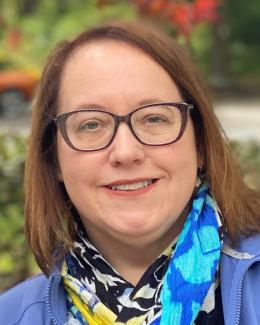In the quest for better batteries, Rose Ruther has found that the positives nearly always outweigh the negatives, and that’s what keeps her coming back to the lab.
Ruther works on novel materials to create batteries with higher energy density at a lower cost as part of the Roll to Roll Manufacturing Group in the Energy and Transportation Science Division. She researches higher voltage materials for the cathode, or positive electrode, in batteries; higher capacity materials for the anode, or negative electrode; and new electrolyte materials that conduct current.
“When you put those new materials to use, they present new chemistries with new issues to try to understand, such as why some cells don’t last as long or why a newly developed battery may show greatly improved performance at first and then decline. Our goal is to keep that performance going for thousands of charging cycles,” she said.
“Battery science is hard because it’s super messy. You have lots of complicated interfaces—solid materials, liquid electrolyte, and polymers in there—and all of those reactions happen at complex, buried interfaces,” Ruther said. “Sometimes a battery behaves so badly that you know exactly what went wrong. But often it’s much more subtle. You need to figure out which mechanisms may lead to a slow loss of performance. It can be challenging but also a lot of fun. We have lots of tools here at the lab to help us.”
Those tools at Oak Ridge National Laboratory (ORNL) include the specialized analytical equipment for materials synthesis and characterization, as well as the molecular level characterization made possible by the Center for Nanophase Materials Science (CNMS) and the Spallation Neutron Source (SNS). The CNMS and SNS are both US Department of Energy (DOE) Office of Science User Facilities. Ruther also leverages capabilities at the National Transportation Research Center, a DOE Office of Energy Efficiency and Renewable Energy User Facility, and the ORNL Battery Manufacturing R&D Facility (BMF), where scientists can analyze every aspect of large-format battery production from raw materials to finished product testing.
At the SNS, Ruther uses the POWGEN beam line to better understand the structure of novel polycrystalline materials and how they may change during battery cycling. For instance, recent research into the use of a nickel oxide cathode found that as the battery cycles, the material slowly starts to lose its ability to store lithium. “That could be related to changes in the nickel oxide’s crystalline structure, and that is something we can characterize very well at the SNS,” she said.
Ruther began her time at ORNL as a postdoc in the lab performing Raman and Fourier-transform infrared spectroscopy and electroanalytical chemistry as she worked on new cathodes for lithium-ion battery cells and electrolytes for supercapacitors.
Leveraging basic materials science and applied technologies
The focus of her fundamental research has been on making materials in batches and testing them in small format cells, like button or coin cells, Ruther explained. At the BMF, co-located with DOE’s Manufacturing Demonstration Facility at ORNL, Ruther has access to a state-of-the-art dry room for researching larger format cells.
As an R&D staffer, Ruther now splits her time between the applied and the basic research labs. “It helps to have a foot in both. Especially if you are doing research using neutrons, you need lots of material, and so it helps to be able to make the larger format battery cells for those measurements,” she noted.
Ruther credits enthusiastic teachers and an Oak Ridge childhood for nurturing her interest in science. She worked two summers as an undergraduate on carbon sequestration projects at ORNL while attending Florida’s New College on a full scholarship, where she earned a bachelor’s degree in chemistry and physics. She then spent a year performing materials research on a Fulbright fellowship at the Max Planck Institute of Microstructure Physics before joining the PhD program in chemistry at the University of Wisconsin–Madison. Her doctoral thesis was on molecular interfaces in electronic materials.
What drives this scientist forward? The surprises. “I’m amazed at how often I’m wrong, and that’s part of the job—it’s exciting and essential to our work,” Ruther said. She also credits the collaborative nature of her research. “Oak Ridge is a great place to work because of the people. We have world-class facilities and instruments, but you must also have good people to work with—it’s the most important thing.”
Ruther has an eye on where the fast-moving field of battery research may be headed as well. Although her current work is largely focused on vehicles, she cites other promising areas like high energy-density batteries for drones and energy storage for the electrical grid—designing efficient ways to store energy on a grid increasingly reliant on intermittent renewable generation, for instance.
Away from the lab, Ruther loves to explore the outdoors, whether riding her bike on area greenways or hiking some favorite spots in Frozen Head State Park and the Smoky Mountains.
ORNL is managed by UT-Battelle for the Department of Energy’s Office of Science, the single largest supporter of basic research in the physical sciences in the United States. DOE’s Office of Science is working to address some of the most pressing challenges of our time. For more information, please visit http://energy.gov/science.



